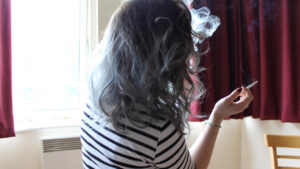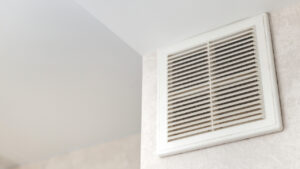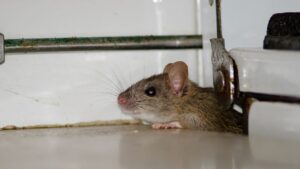Your home’s air ducts determine the quality of airflow in your house. Healthy ducts mean fresh quality air, while dirty, clogged ones bring more dangers than just stuffy indoors.
Clogged up with dust or taken over by unseen microorganisms, the hidden network that keeps your home cozy might be compromising your health. And to tackle the invisible threats lurking in your air ducts, it’s crucial to understand how to disinfect air ducts.
This blog tackles everything you need to know about fighting air pollution in your home. It explores the main methods of disinfecting air ducts in your home, plus the best preventive measures to avoid dirty ducts.
But before then, what air duct contaminants are we talking about?
The Main Contaminants of Your Home’s Air Ducts
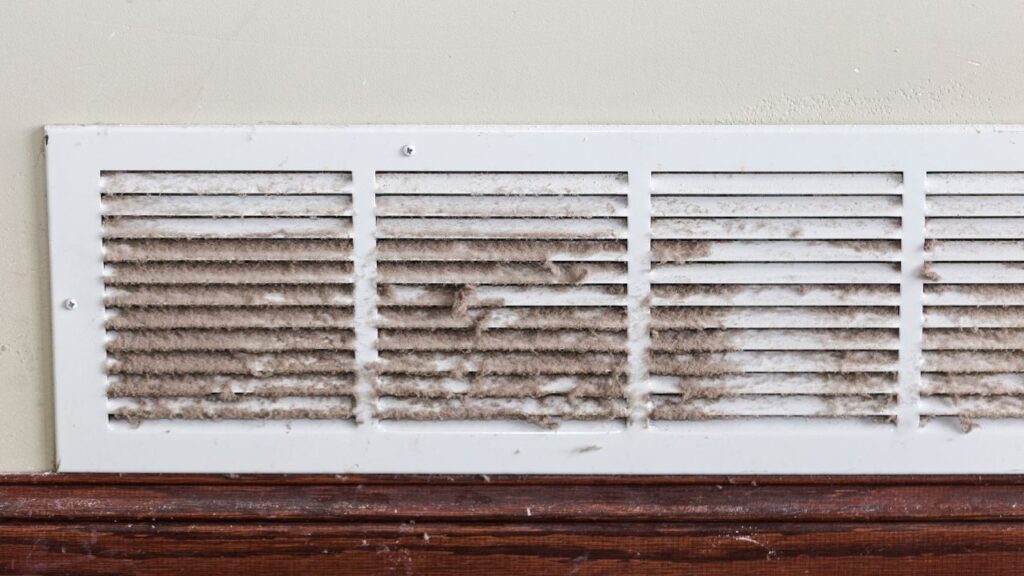
The air ducts can be a hub for so many unwanted particles and pathogens. And understanding what exactly gets into your air ducts can help you in keeping them clean. So, what contaminations make it necessary to disinfect the air ducts.
- Dust – Air ducts easily accumulate dust, dirt, and particulate from indoor air circulation over time. Dust buildup impedes airflow and can be re-released back into the indoor environment.
- Dander – Pet dander shed from furry friends is easily sucked into the ductwork. Animal dander is a common allergen and keeps circulating without proper duct cleaning.
- Pollen – Tiny pollen particles from trees and plants are distributed through the home via dirty HVAC systems leading to allergy and asthma triggers.
- Mold – Mold spores proliferate in moist, dirty ducts forming allergenic patches inside the system. Proper moisture control prevents this. So, be on the lookout for water damage or leaks.
- Bacteria – Bacteria colonies can breed in impacted grime and dirt inside air ducts and then spread through the home leading to diseases.
- VOC Residues – Volatile organic compounds from household cleaners and chemicals leave residues that get trapped in ductwork and continue off-gassing.Smoke Residues – Homes with smokers will accumulate toxic tobacco smoke residues in ducts that then circulate back through the living space.
- Pest Droppings – Rodents and bugs that get into ductwork leave behind contaminant droppings as they travel the system.
Keeping your home’s air ducts clean through professional HVAC cleaning removes these unhealthy contaminants for better indoor air quality.
Now, let’s learn how to disinfect air ducts. Here are the best air duct disinfection methods.
Vacuuming and Cleaning
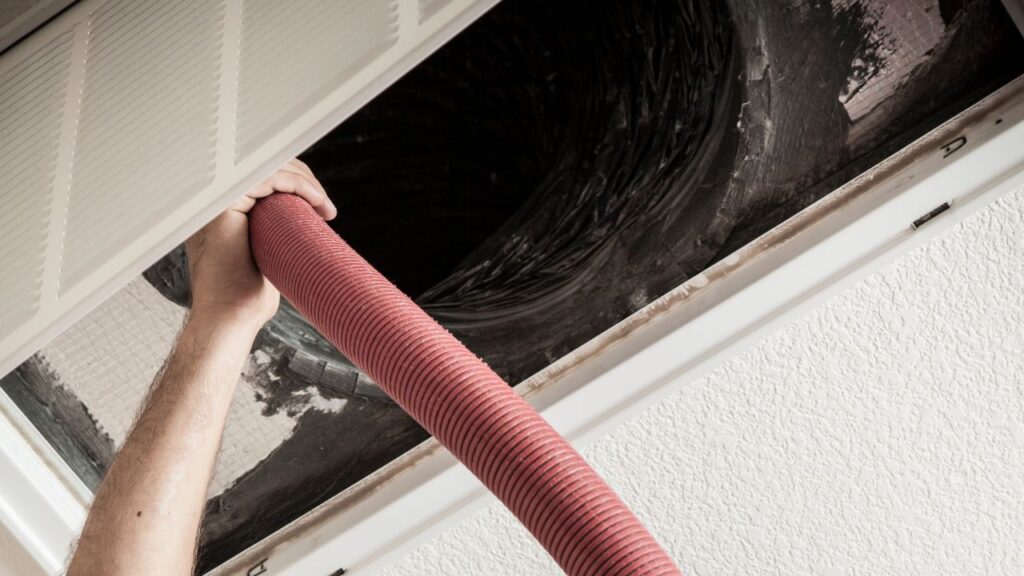
Homeowners often overlook the necessity of maintaining clean air passages. Yet, breathable air is critical for health and comfort. Regular vacuuming of the air duct network using a vacuum cleaner is a cornerstone in preventing dust accumulation and promoting superior indoor air quality.
Equipped with specialized vacuums, a thorough air duct cleaning targets every nook and cranny. High-powered suction dislodges stubborn debris, including dirt, dander, and various particulates. This step is pivotal in mitigating the risk of allergy flare-ups and respiratory issues.
For complex and hard-to-access duct work, the negative pressure method works best. First, the method uses compressed air and a brush to detach debris from the ductwork. From here, the loose debris is vacuumed out using a vacuum cleaner.
After the initial vacuuming, additional cleaning procedures are employed to ensure a comprehensive approach to disinfection. Using professional-grade equipment and EPA-recommended solutions, experts meticulously sanitize air ducts, ridding them of bacteria, mildew, and potential mold spores. Air filters are also thoroughly inspected and cleaned.
The main types of vacuuming methods include;
- Wall-mounted vacuums are powerful portable units installed outside the home to draw air through ducts for cleaning. More effective than handheld vacuums.
- Truck-mounted vacuums are the most powerful option, generating over 10,000 CFM of suction. The entire duct system can be extracted through hoses attached to the truck.
- Negative air duct vacuuming involves installing a containment with HEPA filtration at the HVAC return. Strong suction pulls contaminated air through the ducts and into the filter.
EPA-Registered Disinfectant Solution

Ensuring clean air circulates throughout a home is not just about removing visible contaminants – it’s also about eradicating the unseen threats that lurk within the duct system.
A professional-grade, EPA-registered disinfectant solution plays a pivotal role in this war against microscopic invaders. Some of the most potent disinfectants approved by the United States Environmental Protection Agency include:
1. Sporicidin
For starters, Sporicidin meets strict safety and efficiency guidelines. This makes the antimicrobial agent an effective way of purging air ducts of stubborn microorganisms, ensuring a healthier breathing environment.
Sporicidin’s formulation, engineered to meet rigorous safety and efficacy standards, provides a robust defense against the proliferation of bacteria and mold within duct systems. Its widespread use by professionals reaffirms its unparalleled ability to maintain cleanliness and mitigate health hazards. This makes it a trusted ally in residential air duct sanitation efforts.
2. Chlorine-dioxide-based Cleaner
Another EPA-registered disinfectant, and our preferred method of disinfecting air ducts in Virginia Beach, is a chlorine-dioxide-based cleaner. We use a product called Enviro-con. It is a no-rinse odor eliminator that is effective against various pathogens and is suitable for use in HVAC systems, residential homes, and commercial buildings.
We have found that when this product is applied with a thermal digger, it produces the highest level of cleanliness. And it is even approved to effectively sanitize SARS and COVID-19, making it perfect for our neighbors.
3. Disinfectant Fog
In the quest for pristine air quality, an innovative method has emerged – the application of a disinfectant fog.
This advanced technique utilizes a fine mist to distribute antimicrobial agents, efficiently navigating the labyrinth of ductwork.
Such methods as employing Bio-Fresh—a solution acknowledged for its efficacy—envelop airways in a sanitizing fog, proficiently halting the spread of pathogens. This ensures a secure and clean breathing environment within the home.
Bio-Fresh, Enviro-Con, or other Brands
As an innovative tool in cleansing air systems, Bio-Fresh stands out for its ability to bind and neutralize a spectrum of airborne antagonists.
The practical application of this disinfectant fog works wonders in air ducts, making it a go-to choice for specialists aiming for a nontoxic yet potent remedy against impurities that affect indoor air quality.
Correct Application of the Disinfectant Fog for Air Duct Sanitization
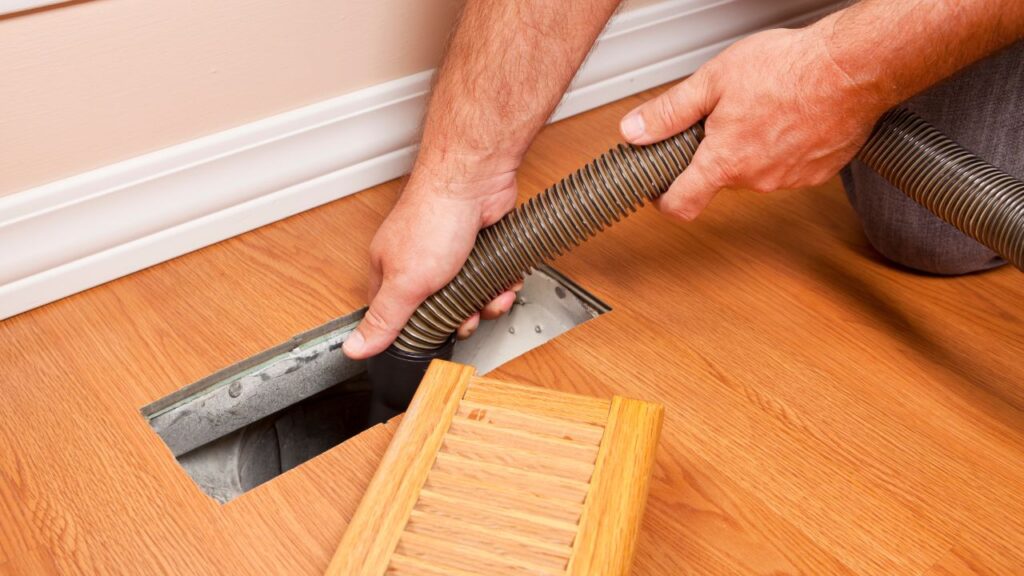
Professionals approach air duct sanitization with precision, employing disinfectant fog at strategic intervals for maximum effectiveness. They initiate the process after a meticulous inspection and cleaning of the ductwork using a vacuum cleaner. This ensures the fogging agent reaches deep within the system, providing an even and comprehensive distribution.
The correct use of disinfectant fog involves specialized tools that create a fine mist covering every square inch of the duct interior. Experts carefully select the antimicrobial solution, ensuring it adheres to the surfaces inside the ducts for the appropriate period to counteract air pollutants and pathogens.
After the application of the disinfectant fog, technicians ensure proper ventilation to facilitate the dissipation of any residual mist. This step is crucial to maintaining the balance between effective sanitization and preserving indoor air quality, leaving behind a clean environment free from harmful microorganisms.
Ways to Prevent Air Duct Contamination
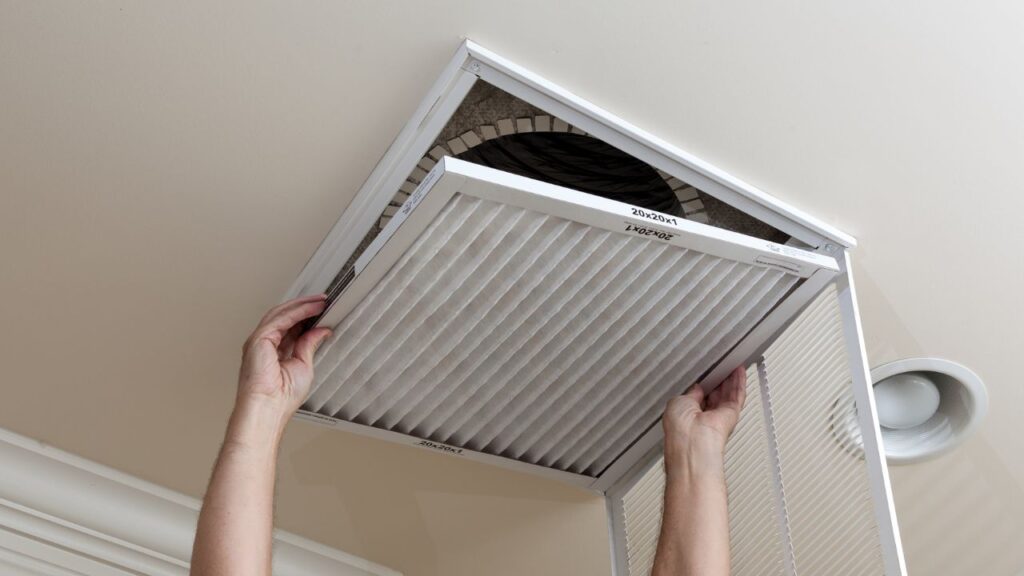
Preventing your home’s air ducts from becoming contaminated requires a proactive, multilayered approach. First, change air filters regularly, at least every 3 months, to catch particulates and maintain clean air ducts. Also, have a qualified HVAC technician annually sanitize the ducts to clear built-up debris, dust, and dirt. But between professional cleanings, use your vacuum cleaner to vacuum accessible ducts and vents yourself every year.
Sealing muddy outdoor air intake is also an effective way to prevent dirt infiltration. Ensure the air intake is free of foliage or other obstructions as well. You should also repair damaged ductwork that allows unconditioned air to enter.
Keep humidity within 40-60% to inhibit mold growth and promptly fix any water leaks affecting ductwork.
Don’t allow any chemicals, cleaners, or smoke releases near duct openings. Also, strictly isolate construction dust and odors from HVAC intakes.
Lastly, pest-proof the home to avoid duct infestations. Keep duct access panels securely closed.
With diligent filter changes, professional HVAC cleanings, sensible home maintenance habits, and prompt issue correction, you can help keep contamination from accumulating within air duct interiors. Clear ducts promote healthy indoor air.
Final Thoughts
The pursuit of a home with crisp, clean air is a task Universal Insulation Doctor takes seriously, particularly in the Hampton Roads area of Virginia. A rigorous air duct cleaning regimen, accompanied by the strategic application of disinfectants like Sporicidin and deep-reaching methods such as disinfectant fogs, stands at the front line of this undertaking. Such diligence enhances indoor air quality and shields dwellers from the insidious effects of air pollution and allergens.
You should note that addressing air duct cleanliness is not a one-time event. It is an essential component of home maintenance, particularly for those living in Norfolk, Portsmouth, Virginia Beach, Hampton, and Chesapeake. Air pollution is a major concern that can be mitigated through regular maintenance.
The team at Universal Insulation Doctor leverages industry-leading practices, including the use of HEPA vacuums and fine mist nozzles. This ensures that their service effectively removes contaminants, air pollution and reduces the likelihood of mold and bacteria proliferation.
Homeowners are encouraged to consider the many benefits of regularly scheduled air duct servicing. Engaging with a reputable duct cleaning company can lead to fresher airflow and peace of mind, knowing that your home’s ventilation system is free from dust, vermin, and chemical pollutants. To learn more or schedule a consultation, contact Universal Insulation Doctor today for an impeccable air duct cleaning service in the Hampton Roads region.
FAQ
What solutions can I use to disinfect my air ducts?
Many air duct cleaners use diluted bleach solutions or antimicrobial products containing quaternary ammonium compounds to disinfect duct surfaces. Other green disinfectants like Benefect or SteraMist can also be applied. Avoid heavily scented or hazardous solutions. Ensure proper ventilation to reduce air pollution and maintain indoor air quality. Use a vacuum cleaner to remove debris from the air filter.
How often should I disinfect the ducts in my home?
For healthy ducts, the EPA suggests disinfecting air ducts every 3-5 years as part of a complete HVAC cleaning by professionals. Homes with residents who have compromised immune systems or known mold issues may need more frequent disinfection. Proper ventilation and humidity control also help minimize microbial growth between cleanings. According to the United States Environmental Protection Agency (EPA), proper ventilation and humidity control are crucial for maintaining good indoor air quality.

